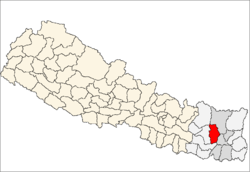Bhojpur, Nepal
| Bhojpur Municipality भोजपुर नगरपालिका | |
|---|---|
| Municipality | |
|
Bhojpur, Nepal | |
 Bhojpur Municipality Location in Nepal | |
| Coordinates: 27°10′N 87°3′E / 27.167°N 87.050°ECoordinates: 27°10′N 87°3′E / 27.167°N 87.050°E | |
| Country |
|
| Zone | Kosi Zone |
| District | Bhojpur District |
| Population (1991) | |
| • Total | 5,823 |
| Time zone | Nepal Time (UTC+5:45) |
| Postal code | 57000 |
| Area code(s) | 029 |
Bhojpur Municipality (27°10′N 87°3′E / 27.167°N 87.050°E) is a town in Eastern Nepal. It was established on 18 May 2014 merging the existing Bhaisipankha, Bokhim, Bhojpur, Taksar Village Development Committees [1][2] It is the district headquarters of Bhojpur district, a hilly/mountainous district in Kosi Zone. At the time of the 1991 Nepal census it had a population of 5823 people living in 1199 households.[3]
Bhojpur bazaar is home to many Newar businessmen as well as skilled Newar craftsmen, and is famous for its metalwork, particularly khukuri knives. Other major towns in the district include Dingla to the north, Ghoretar to the south, and Taksar near the airstrip, from where flights connect to Biratnagar and Kathmandu. A road is currently under construction to link Bhojpur bazaar with Hile, Dhankuta, Dharan, and the rest of Nepal's North-South Koshi Highway.
Historically it is a part of Majh Kirant/Kirat (middle Kirat), and used to be called "east number 4". Middle Kirat consists mainly of Bhojpur and Khotang districts, the traditional home of kirat Rai people, an indigenous ethnic group of Nepal. In addition to Rais, other ethnic groups include Magars, Gurungs, and Tamangs, as well as castes like Chhetris, Bahuns, and Dalits.
Bhojpur was recently the site of a major incident involving Maoist rebels and the Nepali national security forces on March 3, 2004. An estimated 1,500 Maoists attacked the camps of the security forces at the district headquarters. This incident was the most serious one since the Maoists called off the cease-fire on August 24, 2003. 32 security personnel were killed (both army and police), as well as 42 Maoists rebels, including some women. The telephone tower and the buildings of the District Administrative Office were completely destroyed, while those buildings housing the District Land Revenue Office, Rashtriya Banijya Bank and some private houses were partially destroyed.
Tensions between Maoists and security forces emerged in February 2001 when the Bhojpur VDC headquarters were destroyed. The Khumbuwan Liberation Front (KLF), destroyed the 250-kilowatt micro-hydropower project built by the Chinese on the Pikhuwa river on January 26, 2002. On April 18, 2002, a group of 50-60 rebels destroyed the airport tower by breaking through the gate of the tower, setting it ablaze by pouring kerosene, and destroying important devices by hurling a powerful bomb. Several minor skirmishes had also occurred in northern areas of the district, leading up to the deadly clash in March 2004.
see also
References
- ↑ 72 new municipalities announced My Republica
- ↑ Govt announces 72 new municipalities The Kathmandu Post
- ↑ "Nepal Census 2001". Nepal's Village Development Committees. Digital Himalaya. Archived from the original on 12 October 2008. Retrieved 13 September 2008.
| |||||||||||||

